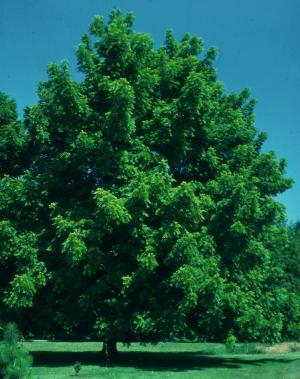Walnut, Black - - Juglans nigra
When grown in the open, the black walnut reaches 75' tall with a round, low branching, open crown that spreads nearly as wide as it is tall. In forests and plantations, the tree may reach 150' tall with a well formed trunk and lower limbs self pruned from « to 2/3 the distance from
the ground. It develops a deep taproot and is difficult to transplant. The hard
to crack shell encases a rich flavored nut. However, the crushed black walnut
shells can stain fingers, clothing, and concrete. The trees bear in 12-15
years. (Partally self-fertile, plant multiple trees to ensure pollination) (zones 4-9)
Alleopathy is the term given to the suppression of growth of one plant species
by another due to the release of toxic substances. Black walnut tree roots
contain juglone, a toxic substance released when the the roots of other juglone-sensitive species come in contact with walnut roots. You must keep a wide separation between the black walnut tree and susceptible plants. A partial list includes tomatoes, potatoes, peas, peppers, cabbage, alfalfa, serviceberry, chestnut, pine, arborvitae, apples, blueberry, blackberry, cherry, azalea, rhododendron, lilac, hydrangea, privet, members of the heath family. The black walnut's poison does not work on all species and some even seem
to thrive on it.


